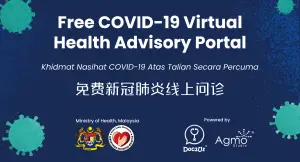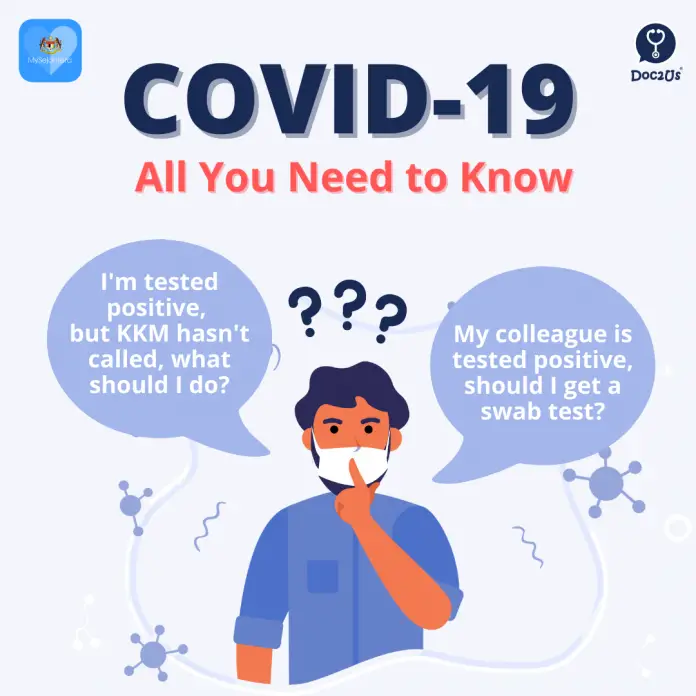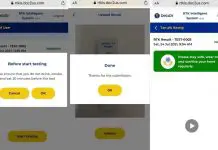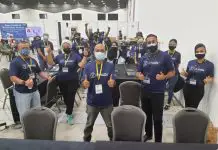A friend of a friend got tested positive. A colleague whom you eat lunch with daily got tested positive. Places you went were shut down due to reported COVID-19 cases. Are you at risk too? Can you still go to work? When should you do a swab test? These questions could swirl about in your head, adding on to the fear and anxiety that has gripped our nation with its astounding number of daily cases. Before worrying yourself sick, keep reading this article, brought to you by Doc2Us, which is here to ease your fears and help you through this pandemic.
What are the symptoms that I should look out for?
Common symptoms: fever, dry cough, tiredness, loss of taste or smell
Less common symptoms: aches and pains, sore throat, diarrhoea, conjunctivitis, headache, rashes on skin, or discolouration of fingers or toes
Serious symptoms: difficulty breathing or shortness of breath, chest pain or pressure and loss of speech or movement

What should I do if I have some of the above symptoms?
Determine if you had been in close contact with a confirmed positive COVID-19 patient. If yes, do a PCR swab test. However, if you are unsure if you have had contact with a confirmed positive case and are still worried, you can do a RTK Antigen test for screening purposes from day 5 of symptoms onwards.
If my RTK Antigen result is +ve, do I need to do a PCR swab test?
Yes. Covid-19 RT-PCR is recognized by MOH as the gold standard for Covid-19 diagnostic tests. If the PRC result returns is positive, you will be treated as a confirmed case of COVID-19.
My friend got tested positive, should I go for a swab test?
This depends on how ‘close’ you are with the close contact. Definition of close contact means:
1. People whom you eat and sleep together with
2. Meeting face to face for more than 15 minutes, less than 1m distance apart in
a confined area
3. Not meeting face to face but in the same confined room without air
conditioning for more than 2 hours
4. In the same car for more than 2 hours
If you are in close contact with your friend, A and A got tested positive, you should go for a PCR swab test and be under home surveillance. If your result comes back positive, you should get treatment accordingly and be quarantined. If your result comes back negative, you should be under home surveillance for 10 days. If you are in close contact with B and B is in close contact with A who is tested positive, you need to be under home surveillance and wait for B to get his/her result. If B is tested positive, you will need to get tested as well. If B is tested negative, you are safe and can continue to go to work.
If you are in close contact with C who is in close contact with B, stay informed with C’s swab test result and you can continue to go to work. If B is tested negative, you are safe. If B is tested positive, C needs to get tested and be under home surveillance and you need to be under home surveillance as well while waiting for C’s result. If C gets tested positive, you should get tested too. If C gets tested negative, you are safe and can continue to go to work.

Can I do a swab test at government sectors?
Yes, you can call the COVID-19 Assessment Centre first to arrange for a COVID-19 swab test. Get the phone number at http://covid-19.moh.gov.my/hotline.
Swab Test Prices for Malaysians:
- PCR: RM150
- RTK-antigen: RM60
- RTK-antibody: RM30
Swab Test Prices for Non-Malaysias:
- PCR: RM250
- RTK-antigen: RM120
- RTK-antibody: RM60
If I am tested positive at a private sector, what should I do?
If you have mild symptoms and can be managed with over-the-counter medications such as paracetamol, cough syrup, lozenges, you can quarantine at home and monitor your temperature and blood pressure daily. After 10 days, you are no longer infectious and can resume normal activity.

What should I do during my quarantine at home?
1. The sick person should wear a mask around other people to reduce spread of droplets. Caregivers should wear a mask around the sick person. Throw the used mask into a closed bin and perform hand hygiene.
2. Prepare a room for the use of patient only. Stay in a specific room and away from other people in your home. Use a separate bathroom, if available. If this is not possible, the patient may use a common bathroom, but it should be cleaned after each use with at least water and soap.
3. Do not eat with other people and do not share food.
4. Avoid sharing personal items (e.g: dishes, cups/glasses, towels, bedding, electronics).
5. Avoid face to face interaction with family members. If unavoidable, patient and family member must wear a mask when face to face and maintain a physical distance of 1m.
6. For contaminated items, put in a trash bag and wash your hands afterward.
7. Disinfect high touched areas (e.g: doorknobs, light switches, bed, table, remote control, bathroom) and any other item the patient comes in contact with at least once daily.
8. Patient’s laundry should be washed separately and hands should be washed thoroughly after handling dirty laundry. If possible, wash laundry at the warmest setting or with warm water.
Source from University of Malaya Medical Centre

When should I go to the hospital?
When you experience symptoms such as shortness of breath, chest tightness, signs of dehydration such as frequent vomiting, diarrhoea and reduced urine output, coughing up blood, unable to tolerate orally, altered state of consciousness (irritability in infants, lethargy in adults), cyanosis (purple- blue lips or fingers).
Advice for caregivers:
- Caregivers should use a mask when in the same room as the patient, or when at a distance of less than 2 meters from the patient
- Maintain at least 1 meter distance with patient to attend to their needs
- Do hand hygiene, wash your hands with soap and water regularly especially
after caring for the sick - Wear gloves when you touch or have contact with the patient’s blood, stool, or body fluids such as saliva, mucus, vomit, and urine. Throw out gloves into a lined trash can and wash your hands right away
- Avoid touching your eyes, nose, and mouth
- Clean and disinfect surfaces frequently
- Stay home and avoid having visitors
- Monitor your health for COVID-19 symptoms such as fever, cough, tiredness, while caring for the person who is sick

(For patients who have been tested positive) After 10 days of quarantine, what should I do?
Do you have the pink band? If yes, you should have a notice letter that was given together with the pink band. Refer to the date stated and COVID-19 Assessment Centre (CAC) to report to in order to remove the band. A letter will be issued upon removal of the band.
If you do not have the pink band, after 10 days of quarantine, go to the nearest CAC to get a letter in order to change the status in MySejahtera.

More questions?
If you have more questions or require medical consultation, talk to us via the Doc2Us app or the MySejahtera app virtual health advisory. We have more than 100 healthcare professionals ready to help and provide you with advice and recommendation. Doc2us is with all Malaysians to fight through this pandemic together to help reduce some load from Ministry of Health Malaysia.
















